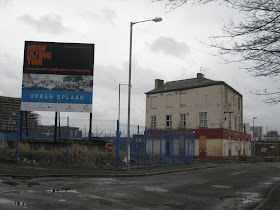The
Cob o' Coal on Cardroom Road was, until very recently, the only remnant of the old Cardroom Estate in Ancoats, just behind the retail park on Great Ancoats Street. It was originally a Threlfalls house, called the
Colliers Arms, on what was then Cannel Street, first licensed in 1823 [1]. In more recent times it was modernised and took on its adopted nickname to become the Cob o' Coal, and the pub survived the first Ancoats clearance and was one of the Cardroom Estate's most popular pubs.
 Cob o' Coal, Cardroom Road. (c) Miles Platting, Ancoats and Collyhurst Facebook [1].
Cob o' Coal, Cardroom Road. (c) Miles Platting, Ancoats and Collyhurst Facebook [1].
The Cob o' Coal is shown here thanks to
Alan Winfield at Pubs Galore with a very different colour scheme. When the Cardroom experiment failed (due to poor street layouts, lack of access and amenities, and anti-social people making it a police no-go area) the pub remained while the council houses and flats were demolished.
Colliers Arms, Cannel Street, 1930s. (c) Neil Richardson [1].
"It’s retention is as much symbolic as anything else and we want it to be a watering hole which is a central focus for the community" said the developers. When selling the concept of the New Islington development to locals and investors, Urban Splash said. "The Cob O’ Coal Pub has stood on this site for years. The people of Ancoats have drank there since the industrial revolution provided them with the chance to lead the world, more recently, dying industry and failing housing has made it more useful for drowning sorrows... but Ancoats is back and we think the Cob O’ Coal should be given the chance to thrive again... [3]"
Sadly, it wasn't to be, as a combination of a fire (possibly - I'm sure this was reported quite recently but can't find any evidence), and probably Urban Splash changing their minds, led to the Cob O' Coal's demolition only a few years ago.

















































